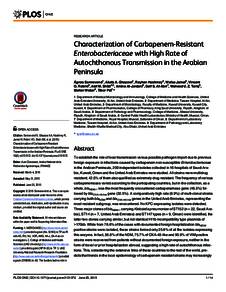Document
Characterization of carbapenem-resistant Enterobacteriaceae with high rate of autochthonous transmission in the Arabian Peninsula.
Identifier
DOI: 10.1371/journal.pone.0131372
Contributors
Ghazawi, Akela A., Author
Hashmey, Rayhan., Author
Jamal, Wafaa., Author
Rotimi, Vincent O., Author
Shibl, Atef M., Author
ِAl-Jardaniyah, Amina., Author
Al-Abri, Seif S., Author
Tariq, Waheed U. Z., Author
Weber, Stefan., Author
Pál, Tibor., Author
Publisher
Public Library of Science.
Gregorian
2015-06
Language
English
Subject
English abstract
To establish the role of local transmission versus possible pathogen import due to previous foreign exposure in infections caused by carbapenem non-susceptible Enterobacteriaceae in the Arabian Peninsula, 200 independent isolates collected in 16 hospitals of Saudi Arabia, Kuwait, Oman and the United Arab Emirates were studied. All strains were multidrug resistant; 42.5% of them also qualified as extremely drug resistant. The frequency of various carbapenemases varied according to the participating countries, but in the collection, as a whole, blaNDM-1 was the most frequently encountered carbapenemase gene (46.5%) followed by blaOXA-48-like gene (32.5%). A comparatively high rate (8.9%) of multi-clonal strains carrying both blaNDM and blaOXA-48-like genes in the United Arab Emirates, representing the most resistant subgroup, was encountered. No KPC-expressing isolates were detected. Three major clones of blaNDM-1 carrying Klebsiella pneumoniae of ST152 (n = 22, Saudi Arabia), ST14 (n = 7, United Arab Emirates) and ST147 types (n = 9, Oman) were identified, the latter two clones carrying similar, but not identical HI1b incompatibility type plasmids of >170kb. While from 78.6% of the cases with documented foreign hospitalization blaNDMpositive strains were isolated, these strains formed only 25.6% of all the isolates expressing this enzyme. In fact, 56.8% of the NDM, 75.7% of OXA-48-like and 90.9% of VIM positive strains were recovered from patients without documented foreign exposure, neither in the form of travel or prior hospitalization abroad, suggesting a high rate of autochthonous infections. This, considering the extensive links of these countries to the rest of the world, predicts that trends in the local epidemiology of carbapenem resistant strains may increasingly affect the spread of these pathogens on the global scale. These results call for improved surveillance of carbapenem resistant Enterobacteriaceae in the countries of the Arabian Peninsula.
Member of
ISSN
1932-6203
Resource URL
Category
Journal articles



